
(Click to Enlarge)

West of House
I am standing in an open field west of a white house with a boarded front door. There is a small mailbox here.
Ok, I'm actually at the end of the driveway, facing the house's south side. And the mailbox is attached to the facade, next to the front door, which isn't really boarded up. But the house IS white. See?

(Click to Enlarge)
Since last year this has been the new home of YOIS, featuring 460 square feet of brick-walled finished basement, partway below ground for added protection, but at the top of a hill to minimize the chance of flooding. It's the ideal library room for lining the walls with game shelves, a cool, dry place with a consistent temperature. When I was house-hunting I chose it for just these qualities. The entire downstairs, sans garage, is essentially my "lair": In addition to the games, it houses my current PC and modern games, my testing station for verifying disks, and my console systems.
The new place is a collector's dream. There is plenty of space for expansion -- I was able to get my personal collection, all my gaming magazine back issues, and the entire stock of Shoppe trade items shelved, with space to spare, and a big enough area in the center of the room to add up to four more cases back-to-back if (make that WHEN) needed. My Infocom greys, formerly confined to a large trunk, are now out in public view. And no more need to stack games on the floor where they could be kicked, stepped on, etc.
 |
 |
 |
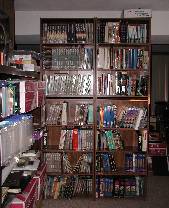 |
The Insurance Game
The major elementals representing hazards to a software collector are: Air. Fire. Earth. Water. And... enraged spouses on the rampage.
Feeble jests aside, have you ever stopped to consider the possibility that your collection could be partially or completely lost to a tornado, fire, earthquake, flood, or violation by another person? The flooding of the Origin Museum following last winter's heavy snows on the east coast convinced me that, while definitely not as common as a shrinked C64/+4 Cutthroats, neither are such occurrences Infinitely Improbable![]() . I vividly recall Joe Garrity's story at PhillyClassic of lugging his irreplacables (Akalabeth, Lord British Starter Kit, Caverns of Callisto) through knee-high water that had risen to within an inch of the heavy safe containing them. Thankfully only duplicates were lost in that disaster, but it does raise an important question: How much is your vintage software collection worth, in terms of both monetary and sentimental value?
. I vividly recall Joe Garrity's story at PhillyClassic of lugging his irreplacables (Akalabeth, Lord British Starter Kit, Caverns of Callisto) through knee-high water that had risen to within an inch of the heavy safe containing them. Thankfully only duplicates were lost in that disaster, but it does raise an important question: How much is your vintage software collection worth, in terms of both monetary and sentimental value?
If you ever go through your shelves and add up the typical selling price of every single game you own, including all your trade dupes, you might be surprised at just how high the bottom line comes out. I know I was. Most of us have spent years of our lives collecting this stuff, for various reasons. It's a lot of fun accumulating it, meeting other people and seeing what they'll pay for different items. It's interesting from an historical standpoint, watching game packages evolve over time. And it's an investment as some of these early games age and appreciate in value (or sometimes, frustratingly, depreciate as more copies of rarities are discovered or all the high rollers acquire theirs). And although I have yet to meet any serious collectors who are in it purely for the money, a large game collection can represent a sizable amount of cash.
Not that most of us would ever sell ours, if we could help it. But in the event of a natural disaster you'd need to know the combined worth of your stuff to file an insurance claim. As bad as losing all or part of your collection might seem, it would suck far worse to lose your "irreplaceables" with nothing to show for them. Obviously cash is a poor substitute for a shrinked Starcross saucer, but at least it's some consolation compared to getting nothing at all. It certainly wouldn't make up for the effort spent tracking down every piece you owned... in the same condition... at the same level of completeness... for the same machine, if you're a platform-specific collector. But the hunt is the fun part, it's the thought of paying all those collector prices again that would take a lot out of you, and that's where an insurance payout would speed up the process of rebuilding a destroyed collection from scratch.
So when I moved to my new home and was revising my insurance policy, I explained the situation to my insurance agent and asked her opinion. As I expected, this was the first time she'd ever heard of anyone wanting to insure such a collection. We're still not in the mainstream perception of what's valuable or collectible. While your typical homeowner's insurance policy does provide basic personal property coverage, it would mean lumping your collection together with all your other stuff. Also, there are limits to personal property coverage, and if you exceed this you need to either buy more insurance or get what's called a "rider" attached to your policy. I prefer this method since it specifically covers what you have. The downside is you need to provide an itemized list, and some sort of proof of their value. The more documentation you can provide, my agent told me, the better the chance that the underwriters will agree to cover you.
This type of coverage is actually very affordable. My insurance company quoted me a price of $4.50 per $1000, annually. So a $10,000 rider would only cost $45 per year! Quite a bargain considering this is less than the individual cost of many collectible games. That's with a house... Apartments are a little more expensive since the building itself is shared by multiple occupants, with a greater chance of someone doing something like lighting a mattress on fire to have an indoor cookout.
Here's what I'd recommend:
Keep in mind that I have yet to actually try getting money from an insurance company, as I've never experienced a personal disaster firsthand. But it's a safety net, there if you need it even though you always hope you never will. Also keep in mind that every insurance company operates a little bit differently. Call yours up and get their take on the situation. Most probably will not recognize old software as collectibles, but if you can back their alleged value up with some evidence, I doubt they'll turn away your business.
And yes, I really have heard of one collector who lost a valuable game package to an angry spouse's wrath.
One Man's Drash...
Well, it took eight years, but it finally happened. In September of 2003 the first-ever auction for Ultima: Escape from Mt Drash appeared on eBay, and it closed at a mind-blowing $865 (just for a loose cassette)! A second one followed three months later for only $100 less.
The story of Mt Drash, shrouded in collector-lore and apocrypha, is well-known but is such a great tale that I just have to repeat it. The game was programmed by Richard Garriott's friend Keith Zabalaoui (pronounced "zah-bah-LAO-ee", third syllable rhymes with "how"), who is credited as one of the programmers for Ultima II, and also did some of the monster design on the Computerland Akalabeth... That's the original version Garriott sold maybe a dozen or so copies of, from the Dallas area computer store where he worked as a teenager.
Sierra commissioned Zabalaoui to write the game, and published it as part of their SierraVenture line, a label the company used for its adventure titles such as the Hi-Res Adventures series (Mystery House, Wizard and the Princess, Cranston Manor, etc.), the original big-box release of Ultima II, and Sierra's re-release of Ultima I. Mt Drash, in fact, has the same castle box art as the Sierra Ultima I. After the popularity of the Ultima series had been established, Sierra decided the game would sell better if marketed as an Ultima title, and slapped the name on it. Richard Garriott had left Sierra to found Origin by this time, and apparently didn't find out about this until years later.
The game itself is a very simple maze game with monster-slaying. There is no plot to speak of, and aside from the "Mt Drash" reference (which is a mountain in the land of Sosaria), no connection to the rest of the series. It is an Ultima in name only. According to Vintage Sierra, the company was actually embarrassed by the game, and even denied that it existed. An advertisement ran in an issue of Compute! magazine in 1983, but players never sighted it in stores. For years Mt Drash was regarded as unreleased, most likely aborted when the video game market crashed in 1983-84, until some enterprising collectors tracked down Zabalaoui and confirmed its existence. A scant few copies surfaced in the late 1990s after countless UseNet posts.
The game was only released for the Commodore VIC-20 computer. It is on cassette tape, not a cartridge as is sometimes believed. Apparently Sierra sold a minimal number of copies, just enough to recoup their production costs and pay Zabalaoui for his work. Best guesstimates suggest between 2,000 and 5,000 packages were produced. There are rarer games out there, to be sure, but you'll be hard-pressed to name one that's more sought-after. A popular rumor suggests that all the leftover copies were buried at the foot of a mountain somewhere (similar to Atari's dumping of unsold E.T. cartridges). The truth, according to The Origin Museum, is even stranger: It seems some retailer dumped a bunch of unsold software over the edge of a cliff, and someone digging through the pile at the bottom actually uncovered a Mt Drash! It was horribly beaten-up, but it was there.
When the first Mt Drash auction went up in September, NASA could practically see the resulting chaos from space. The seller, who claims to have found it in a thrift, was apparently negotiating a private deal with one collector when he inadvertently listed it on eBay along with four other VIC-20 games he'd found. Unfortunately a few too many would-be bidders wised the seller up on the game's rarity, as he first added some information lifted from Underworld Dragon's pages, then ended the listing early. I wrote him, and he explained that he received only one bid, but a TON of e-mails from people asking him to close the auction and sell it to them privately. Everyone who intended to bid was likely waiting to snipe so as not to draw attention to it. The seller relisted a few days later with a higher starting bid and reserve price.
After the first auction, word seems to have spread regarding just how much Drash could sell for. When the second one went up, a bunch of us on SWCollect looked at what the seller had recently BID on: He got his copy in a VIC-20 lot he snapped up with a $100 BuyItNow. The listing mentioned VIC games and said "Ultima" but not "Drash", so all the big-name collectors searching on "Drash" every day missed it! Apparently he knew it was worth something because he did a websearch, found my news page, and e-mailed me asking how to identify if the tape was an original. (I assured him that if he got it in a lot with a bunch of other VIC-20 stuff, it probably was.)
Now that they're coming out of the woodwork, it's time to be a bit cautious. The software collecting community has been hit by a spate of counterfeiting in the last year, and Mt. Drash is an obvious target. The two auction sellers were warned about watermarking their pics so unscrupulous sellers can't swipe them and pretend to own a copy. The legitimate collectors who have it are cautious about providing digital copies of the tape, or any detailed scans of the materials, and about keeping a few secrets in case they ever need to expose forgeries. (The idea of withholding information from fellow collectors hurts, but a few lowlifes have made it necessary... How times have changed since Eyal Katz appeared.)
On the other hand, the sheer interest in Drash ensures that anyone selling it is going to attract attention and come under scrutiny. And basic seller behavior offers protection, too. Nobody who knows its value is going to sell one privately, when they'd almost certainly get more for it through an auction. And any counterfeiters will be found out: None will have the willpower to stop after just one, and anybody with 10 boxed copies of Drash better have a damn good explanation. So don't let suspicion make you miss out, but don't let the excitement cloud your judgment either.
Fortunately we now have four confirmed owners who can compare a questionable copy of Drash with their known originals: FortranDragon,
TomMage,
Vintage Sierra,
and the Origin Museum. (Please don't bug them about selling!) There are also a few other unknowns floating around. The first eBay auction was private and to my knowledge the winner hasn't yet come forward. Then there's the guy who supposedly found the one down the cliff, the guy who did the PC port (see below), plus one or two more I've heard about from people who know the owners but "aren't at liberty to say".
Drash Links:
"Games Aren't Readable"
Just about everybody has had a fun collector experience dealing with a Postal Service that just doesn't seem to understand us. If you find these amusing, you're gonna love this'n...
So I go into the post office with an armload of packages to send. A few Half.com items, couple Shoppe orders, nothing out of the ordinary. Just like a hundred times before, I ask for media mail on the Shoppe orders. When the lady behind the counter asks me what's in it I truthfully answer, "games". She informs me that games cannot be sent media mail! Strange, I've been doing it for years, did they recently change the rules? No, it's always been this way. Why, then, can't games be sent media mail? Her answer (getta loada this!): Because games aren't readable.
No foolin', that's what she said! You can't read a game like you can a book, so it doesn't qualify for media rate. Of course that is most illogical, Captain, so I try to reason with her, but it gets me nowhere fast:
Well you don't "read" movies or music CDs either, and they can go media rate.
Yes, but games are different because they are interactive. (The italics is counter-lady talking, BTW.)
Well but you can send other software by media mail, like copies of Windows, right? And you click around in those, so they're interactive too.
Yes, but that's not the same as games. Games are for entertainment.
Then what about DVD movies? Some of those have games on them, so they are interactive entertainment too. But they can go media rate.
Yes, but they are intended primarily for viewing, not for playing.
And so on, ad infinitum, ad nauseum. It's like talking to a not particularly astute brick wall. I didn't even attempt to debate the semantics of text adventures, whether they're a book that you play or a game that you read. I know, I know, counter-lady didn't make the rule, she just follows it. But if you actually read item "i" on the USPS's policy on media mail (the part that pertains to software), it's just vague enough to be completely useless:
| i. Computer-readable media containing prerecorded information and guides or scripts prepared solely for use with such media. |
Now, I ask you, where in there does it say anything about "games aren't readable"? (I totally got around her goofy-ass reasoning, though: I just came back the next day and got a different clerk, who let me send 'em without any hassle. B-)
"I Defended Software Collecting from a Counterfeiter, and All I Got Was This Stupid T-Shirt"
At LAST! This one is so far delayed it's not even funny.
If you collect Infocom and follow eBay, you may have noticed the wave of T-shirt auctions that hit back in December / January of 2002-2003. A genuine Infocom T-shirt is a prize centerpiece for any collection, but until now very little online information about them has existed. The fact that shirts are highly sought after by collectors (witness a $120+ New Zork Times Puzzle Winner) and fairly easy to print (most office supply stores carry transfer paper) makes them an ideal choice for scam artists out to make a quick buck. Which is what happened about this time last year, mere months after Eyal. Fortunately, I think everyone personally involved was warned.
The purpose of this column is to help you identify phony Infocom or other vintage software shirts, in the event anyone else (or the same moron) ever tries selling them again. Keep in mind I have NO issue with self-printed shirts if they're advertised and somehow indelibly marked as such. It's passing off homemades as genuine originals that's a no-no.
Spotting a fake collectible shirt:
![Look at the uneven lines along the letters' edges. [337KB]](./images/columns/fakeshirt1_T.jpg)
|
![Lots of ink seepage, and it's uneven. [85.8KB]](./images/columns/fakeshirt2_T.jpg)
|
Finally, if anyone you don't know asks you for details about your own collectible shirt's tag, be careful what you give out. That faker is still out there, and there are probably others who'd do the same if they had the information. No sense making their jobs easy for them. Sad to say, we probably haven't seen the last of this kind of thing. As our hobby grows more mainstream we'll probably discover more and more attempts. Heck, I figure before this year is up, I'll land sev-- eh, never mind... don't want to encourage them by proposing a challenge.
So, how do we defend the integrity of our hobby against people just out to make a profit? (And I don't mean honest dealers, those who may be interested solely in selling, but who at least only deal in genuine, original, accurately represented items.) Seeking some insight on this issue, I e-mailed Digital Press, a recognized name in the video game cartridge collecting field, a hobby I consider to be a bit further "along" than us, having had several years' head start. Their advice was familiar but reassuring, as it confirms that our recent actions have been on the right track:
One collector has even proposed a more proactive solution, a site where people could post links to questionable items they've spotted on eBay. Something that would serve as a hub for discussion of those items, and a central repository for info on discovered counterfeits. It would need to be moderated, both to keep it on topic and to prevent people from using it as a lash-out tool for petty disagreements. I'd be happy to code up something in PHP, but I don't have the time to maintain it along with everything else. Please e-mail if you'd be interested in helping with something like this.
The one advantage we do have over the cartridge collectors in fighting counterfeiters is that, for them, loose game cartridges are perfectly acceptable. But (aside from a very few ultra-rarities) no computer software collector pays top dollar for a loose disk or an unpackaged / incomplete game. So if someone wants to fake one, they'd have to go all the way: Disks, manuals, boxes. Much more work involved, and many more places to reveal their lack of knowledge and/or overall incompetence in this area.
Okay, now that we've looked at fakes, let's examine a number of real Infocom shirts that have recently been auctioned. If anybody has any they'd like shown off in a future column, feel free to send pics. Please note that some of these images are very large, and will take awhile to load if you're on dial-up.
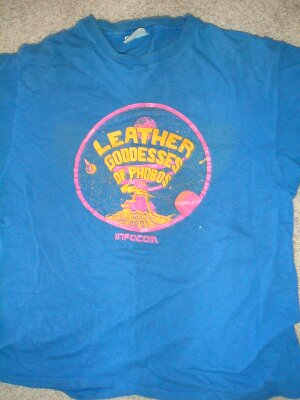 |
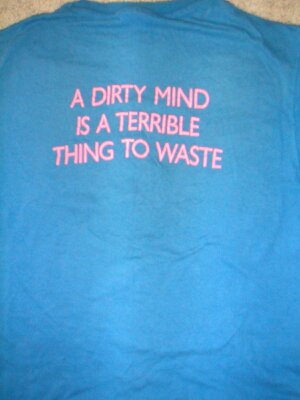 |
(Thanks to Anthony Farmer for permission to repost his images.)
This is the Leather Goddesses of Phobos shirt you could order from Infocom using an exclusive order form included in the game package. It's a garish combination of pink and yellow on royal blue, which somehow fits with the overall mood of the game.
![Clear, well-defined lettering. [53KB]](./images/columns/lgopshirt3_T.jpg) |
![Note the extreme detail. [584KB]](./images/columns/lgopshirt4_T.jpg) |
![Lettering uniformly visible from the back. [328KB]](./images/columns/lgopshirt5_T.jpg) |
![Minimal ink seepage from the front. [580KB]](./images/columns/lgopshirt6_T.jpg) |
![Clear, well-defined lettering. [879KB]](./images/columns/nztshirt1_T.jpg) |
![Colors show through evenly inside. [626KB]](./images/columns/nztshirt2_T.jpg) |
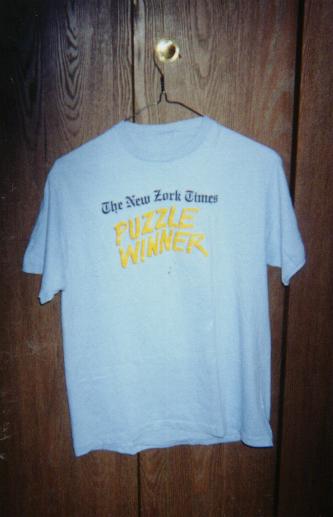
![Sharp edges on the Infocom logo. [256KB]](./images/columns/nztshirt3_T.jpg) |
![Lettering uniformly visible from the back. [269KB]](./images/columns/nztshirt4_T.jpg) |
My New Zork Times Puzzle Winner shirt. Correctly solving one of the puzzles in Infocom's newsletter (and being lucky enough to get chosen in the random drawing from all the correct entries) got you one of these. Or you could wait 15 years and win it on eBay, like I did. I haven't bothered to go through my NZT issues and count exactly how many of these Infocom gave away, but I'd estimate several hundred.
This one definitely looks old, with a couple of frayed seams and a small stain that didn't come out in the wash. A brand-new, never worn one sold on eBay for over $120; I think I paid about $35 for mine. The top two scans shows the front, outside and inside. The colors show through, but evenly. Again notice the sharp lettering of the Infocom logo in the bottom two pics.
![Activision logo over left breast. [126KB]](./images/columns/zorknemshirt1_T.jpg) |
![Zork Nemesis title and design on back. [908KB]](./images/columns/zorknemshirt2_T.jpg) |
Zork Nemesis shirt given away by Activision, most likely in press kits and at trade shows. The complex design around the title on the back (a bit hard to see against the dark fabric) would be difficult for a self-printer to reproduce. This is a heavier tee than the New Zork Times, so absolutely nothing shows through inside. I've seen a number of these sell over the last couple of years, never for more than $15.
![Note the extreme detail in the brick letters. [592KB]](./images/columns/zorkshirt1_T.jpg) |
![Again, no seepage, and it's a thin fabric. [341KB]](./images/columns/zorkshirt2_T.jpg) |
Zork I tee I won on eBay awhile back. Can't remember where these were originally offerred.
![Again we see two distinct colors up against each other, with no bleeding. [640KB]](./images/columns/hhggshirt1_T.jpg) |
![Uniform outlines visible through the reverse side. [227KB]](./images/columns/hhggshirt2_T.jpg) |
![There's an Infocom logo on the back, but mine is pretty well-worn from being... well, worn. [201KB]](./images/columns/hhggshirt3_T.jpg) |
I think just about all of us eventually got the Babel Fish. But not a whole lot of people seemed to have gotten this shirt. Unlike the LGoP, these weren't offerred in the game package, only through the New Zork Times. I managed to get this one off eBay for minimal cost due to the deteriorated condition it's in.
![Front [815KB]](./images/columns/brainshirt1_T.jpg) |
![Back [207KB]](./images/columns/brainshirt2_T.jpg) |
![Wups... glue spill. [58KB]](./images/columns/brainshirt3_T.jpg) |
This is one I won myself on eBay awhile back, a sweatshirt given away at some of the "Bring Your Own Brain" press parties Infocom used to hold, at the Field Museum of Natural History in Chicago. Got it from a former game reviewer, Steve Panak of Antic, who personally attended a couple of these events.
The front features a picture of a human head (left pic), with the brain divided into numbered sections. The back of the shirt (middle) reads "Infocom's BYOB Party" in well-defined lettering, but with no date indicating which particular gathering it may have came from. The thicker fabric of the shirt completely prevents any ink from showing through. Pronounced cracking on the ink clearly marks it as having been worn and washed a few times, and the tag is a bit faded too. There is a stiff stain on the left sleeve (right pic), which Panak attributes to glue or a similar material that may have been packed in with the shirt at one time while it was in storage.
(Note that the brain diagram is not to be confused with Infocom's famous "We stick our graphics where the sun don't shine" magazine ad.)
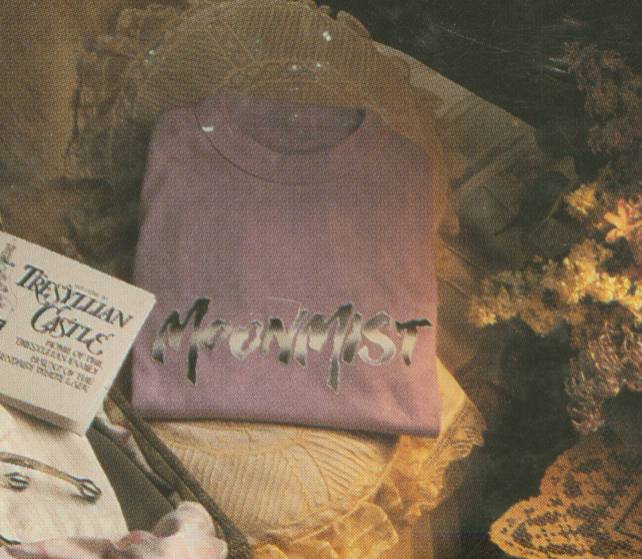 |
If you see a shirt with the Moonmist logo, even if it looks recent, it was likely created by the owner using the iron-on included in the original game package. These are difficult to quantify in terms of scarcity, as the game reached many thousands of players. Unapplied iron-ons do tend to be found in game packages with surpising frequency, suggesting owners may have had some foresight to keep their props in pristine condition (or perhaps they didn't want everyone to know they were Moonmist fans... it was one of Infocom's least-popular titles). In any case, I suspect most collectors would rather have the original unused iron-on.
Okay, what about those "Maya" shirts we've seen a couple of, with the text snippet from Zork?
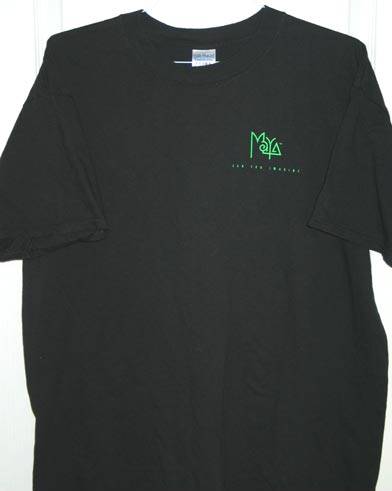 |
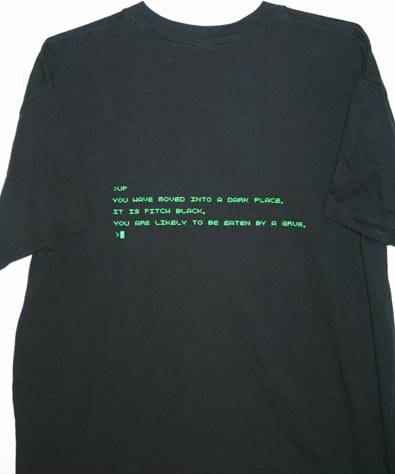 |
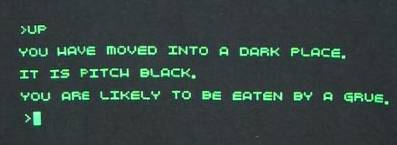
s
Basic black XL tee with a Maya logo over the left breast, and a passage from Infocom's Zork I in greenscreen style lettering on the back. ("You have moved into a dark place. It is pitch black. You are likely to be eaten by a grue.")
This one's a little harder to pin down. While it's clearly a recent shirt (Maya is a flagship 3D rendering program for entertainment industry professionals such as game artists and studio animators), the lettering is sharp and the print job appears to be a high quality one. As Zork I was released as freeware by Activision, there's probably no objection from them for quoting the game text. Perhaps it was intended to demonstrate the extent to which creating imagery on a computer has changed since the days of text adventures.
"That's it?" you're saying. "What about the complete ass-bag who sold the fakes?"
Well, short version, after a lot of back-and-forth, the seller seems to understand that I won't publicly humiliate him so long as he doesn't attempt to sell any more of them. Keyword, "publicly". Yes, there is a TON of behind-the-scenes intrigue regarding this article, but I'm not going to post it here. If you'd like to know the long version, I'll see about telling you privately.
And so, vintage software enthusiasts, the moral of the story is this: Whether you're a dealer or a collector, if you start getting into this particular area of the hobby, make sure you do your research... or you could end up losing your shirt.
I thank you.
 (Planned Renovations... Click Image to Enlarge)
(Planned Renovations... Click Image to Enlarge)| <-BACK | ->HOME<- | <HELP> |